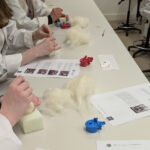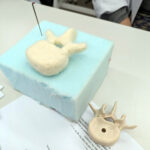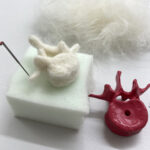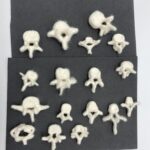Vertebrae? We’ve got your back!
Students on our MSc in Human Osteoarchaeology spend a lot of time looking at bones, funnily enough. But recently, they got the chance to make them… in felt. Why? We’re glad you asked!
Felting is an ancient technique which, traditionally, created a textile by matting together wool using only heat, moisture and agitation. Examples of clothing, rugs and decoration have been found in graves, famously in Scythian Iron Age tombs in the Pazyryk Valley and Ukok plateau in the Altai Mountains of Siberia. Most recently, though, its creation has become a popular craft – sometimes called ‘fibre art’ – using felting needles, a mat and wool.
“I first encountered anatomy felting through ‘I’ve got yer back’, a community collaborative art/science project led by Janet Philp (Head of Administration in the Deanery of Biomedical Sciences) and artist Joan Smith.” said Dr Linda Fibiger, Programme Co- Director MSc in Human Osteoarchaeology. “I created a C2 vertebrae, right at the top of the spine.”
“Joan has, for a number of years, been doing a drawing session with my students, and I thought the felting with Janet would be another, art/craft-science crossover way to approach anatomy, to emphasise to students of Human Osteoarchaeology how important it is to really look at and feel the bone to understand form and function.”
Students selected a plastic cast vertebrae from different areas of the spine as a model. Feedback on the session was very positive, with students commenting that the process really made them look at the structure and different features of the bone casts.
Felting bones, from start to finish
#gallery-1 { margin: auto; } #gallery-1 .gallery-item { float: left; margin-top: 10px; text-align: center; width: 25%; } #gallery-1 img { border: 2px solid #cfcfcf; } #gallery-1 .gallery-caption { margin-left: 0; } /* see gallery_shortcode() in wp-includes/media.php */
- Students working on felting vertebrae.
- A vertebrae takes shape.
- A felt vertebrae with its model.
- Finished felt vertebrae.
Find out more:



